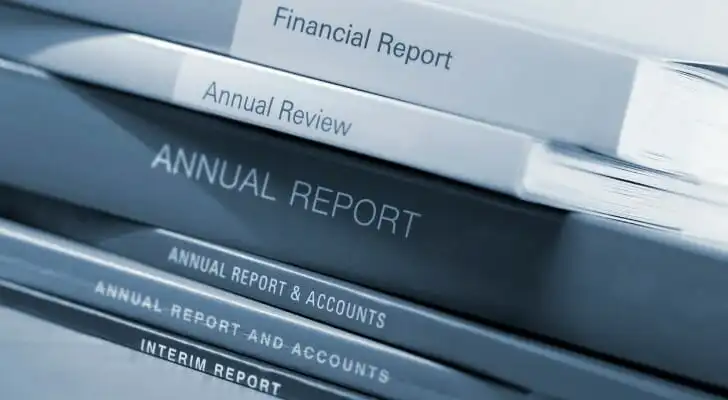A publicly traded company is required by the Securities and Exchange Commission (SEC) to disclose substantial information about its governance, business model and finances. This information allows investors to make an informed decision about whether or not to trust this company with their money. Traders in particular rely on disclosures like this when deciding whether to buy a company’s stock or bonds, the two most common securities sold on the open market by publicly traded firms. Investors looking for expert guidance on this front might consider enlisting the help of a trusted financial advisor.
Among other disclosure forms, the SEC requires that a publicly traded company must disclose this information every year in a 10-K report. This is a comprehensive form in which a company presents virtually every piece of information that it is required to make public. Understanding a 10-K can help you know much more about your investments, but they make for very dense reading.
Understanding a 10-K

All 10-Ks are publicly available documents that investors can find at different locations. Publicly traded companies are required to publish their 10-Ks, which they typically do on their corporate or investor relations websites. However, the easiest place to research a 10-K for any given company is typically the SEC’s EDGAR database. The commission also offers a thorough guide to the document.
A standard 10-K is a lengthy, information-dense document. However, investors can find a few standard pieces of information, including:
Business model and risks
Part I of this form will include information on the company’s core business model, with a statement of the company’s chief revenue streams. In a nutshell, this section of the report tells you how the company makes its money and how it anticipates doing so going forward.
This section also discloses major financial risks faced by the company. This may be the most important part of the 10-K and is the part a prospective investor should read most carefully. These include market risks, liabilities and debts, and any current or potential legal issues. If the company has active or pending lawsuits it must disclose them here, as well as any unresolved regulatory issues.
Financial statements
Part II of the 10-K includes financial data for the company from the past five years. This section shows both the company’s current balance sheet and its prior ones so that you, a prospective investor, can get a sense of the financial trends for this business. You can read through to see how revenue has been trending, look for any buildup of debt, and scan for any other areas of concern.
Contracts and other liabilities
In Part IV of the 10-K a company must list contracts that it can owe money on. For many companies this will particularly involve leases, since lease contracts can create significant financial liabilities for a company.
These are the three main areas that a retail investor should look at when choosing whether to buy into a company. This is generally the easiest information to understand and it’s often the most important. However, it is far from the only information available in a 10-K. Part III of the form, for example, will generally include information in corporate governance and leadership. At the bottom of the form, the company’s independent auditor will include a statement. This is all information that can be both relevant and important to a serious investor.
How to Use a Form 10-K

A 10-K is sometimes difficult for retail investors to understand at first blush. Generally the best option for an investor is to simply begin reading these forms and learn how to do so efficiently through experience.
As you read through these forms, pay particular attention to the information relevant to the securities in which you have an interest. Financial information about the company is always crucial, so read carefully when the company discloses its assets and its liabilities. Does this company look like it has a lot of money coming in the door, or has it incurred payments to match?
For an investor looking to buy bonds, debt should be a particular concern. The most money a company owes, the more it may have difficulty paying all of its creditors. Check the company’s debt-to-equity ratio. For an investor looking to buy stocks, pay attention to historic financial trends. Is this company growing? How have its assets trended over time? If the company seems stagnant, or even contracting, it may not be poised for significant growth in its stock price.
But again, this is a brief overview of what to look for in this comprehensive report. The best way to learn what to look for in 10-Ks is by reading them.
The Bottom Line
A 10-K is a disclosure form required by the SEC for all publicly traded companies. It contains information such as the firm’s financial position, debts and other liabilities, and corporate governance, all key to know for a would-be investor. Sometimes companies will publish for their shareholders an annual report, which is often a distillation of their Form 10-K.
Tips for Investing
- Take a look at a Form 10-K and you’ll quickly see just how complicated investment data can become. A financial advisor can help you understand what’s in it. Finding a financial advisor doesn’t have to be hard. SmartAsset’s matching tool can help you find a financial professional in your area to help you wade through all of the information. If you’re ready to use the tool, get started now.
- If you’re looking at the metrics of a company, there is perhaps no better place to start than the price-to-earnings ratio. This shorthand calculation of a firm’s financial position is one of the most important numbers in the marketplace.
Photo credit: ©iStock.com/fizkes, ©iStock.com/peepo, ©iStock.com/kohei_hara
